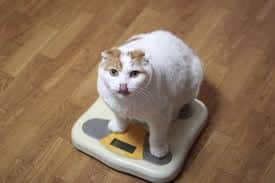
Obesity has become an extremely important health problem in the Western world, not just for people but for dogs and cats too. Obesity in pets is associated with joint problems, diabetes (cats), respiratory issues and decreased life span.
Recent studies show approximately 60% of dogs and cats in the U.S. are obese or overweight, making this an epidemic. Most pet owners don’t realize that their pet has become overweight – sometimes it’s because a fluffy coat can hide their true body conformation and it may also be due to fat being the new normal. Basically, since overweight pets are so common, to most pet owners, a fat cat or dog now seems to be normal.
Why Obesity is Bad
While many of us feel that food equals love (our pets certainly seem to think so), the result of over-feeding and obesity can lead to some serious consequences. Here are some of problems that obese animals face:
Respiratory Compromise
The obese pet has a good inch or two of fat forming a constricting jacket around the chest. This makes the pet less able to take deep breaths as more work is required to move the respiratory muscles. Areas of the lung cannot fully inflate, so coughing results. The pet also overheats more easily. Many cases of tracheal collapse and chronic cough can be managed with only weight loss.
Diabetes Mellitus
Extra body fat leads to insulin resistance in cats just as it does in humans. In fact, obese cats have been found to have a 50% decrease in insulin sensitivity, which leads to type II diabetes just as in people. Weight management is especially important in decreasing a cat’s risk for the development of diabetes mellitus.
Hepatic Lipidosis (fatty liver)
When an overweight cat goes off food or partially off food because of illness or psychological stress, body fat is mobilized to provide calories. Unfortunately, the cat’s liver was not designed to process a large amount of body fat. The liver becomes infiltrated with fat and then fails. A stress that might have been relatively minor, such as a cold, becomes a life-threatening disaster.
Reduced Life Span
A study of age-matched Labrador retrievers found that dogs kept on the slender side of normal lived a median of 2.5 years longer than their overweight counterparts.
Unwillingness to Accept Therapeutic Diets
If the pet should develop a condition where a therapeutic diet is of great benefit, the pet that has been maintained primarily on a diet of table scraps may be unwilling to accept commercial pet food of any kind, much less a food modified to be beneficial for a specific disease process. This unwillingness will hamper treatment.
Increased Surgical/Anesthetic Risk
Obesity poses an extra anesthetic risk because drug dosing becomes less accurate. (It is hard to estimate a patient’s lean body mass for drug dosing if it is encased in a fat suit.) Furthermore, anesthesia is inherently suppressive to respiration and adding a constrictive jacket of fat only serves to make proper air exchange more challenging. And still further, surgery in the abdomen is hampered by the slippery nature of the extra fat as well as difficulty visualizing all the normal structures through the copious fat deposits. One never knows when a pet will require an emergency surgery (to say nothing of regular teeth cleanings).
So is the enjoyment of all those extra treats really worth it?
How Did My Pet Get So Fat Without Eating That Much?
You might think weight management might be easier for a pet than it is for a human. After all, the pet relies completely on someone else for feeding and exercise so it should follow that if the humans in control can regulate feeding and exercise, the pet should lose weight. It seems like this would be true but, as with humans, there is tremendous individuality with how different pets store the food they have eaten. Beyond this, sometimes it is hard to know what a pet is eating or the owner may not have a good sense for how much should be fed. Here are some factors involved.
Owners should remember that when feeding, a cup or scoop can vary based on the size of the cup or scoop.

When food packages refer to a certain number of cups of kibble being appropriate for a certain body weight, they are referring to an actual measuring cup. Any other type of measuring cup sets the pet owner and the pet up for problems.
The other thing to keep in mind, is that individual metabolisms are different from one pet to the next. So feeding guidelines are just that, guidelines. If a pet is too heavy and an owner follows what’s on the bag, then the amount needs to be adjusted.
If an owner has a fat cat or dog and is following the feeding guide on the package, it’s best to get a gram scale, weigh the food and start by reducing the amount by 10% and having your veterinarian help you re-evaluate.
Another way to help pet owners know what the ideal weight for their pet is, is to look at the WASAVA guide for cats and dogs. The links are below.
Cats: https://www.wsava.org/WSAVA/media/PDF_old/Body-condition-score-chart-cats.pdf
Dogs: https://www.wsava.org/WSAVA/media/PDF_old/Body-condition-score-chart-dogs.pdf

